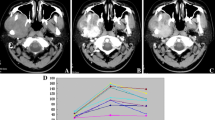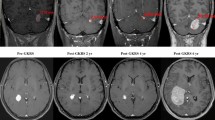Abstract
Background
This is a retrospective study of 11 patients harboring a solitary fibrous tumor (SFT) of the central nervous system (CNS), with special emphasis on unusual clinicopathological and outcomes patterns.
Method
Between 2000 and 2008, 11 patients harboring CNS SFTs were treated at our institution. Patient charts were retrospectively reviewed and tumor location, clinical presentation, imaging characteristics, extent of resection, dural origin, pathological features, adjuvant treatment, and follow-up data were collected, focusing on five atypical cases (four intracranial and one within the spine).
Findings
One intracranial SFT arose from the sella turcica and relapsed threefold during the 6 years following partial removal. Disease progressed as successive isolated local recurrences treated by subsequent surgical interventions and gamma-knife radiosurgery. The MiB-1 labeling index analysis showed a steady increase in these sequential recurrences (ranging from less than 3% up to 6%) without obvious malignant transformation. The second SFT occurred in the cerebellopontine angle and exhibited a high MiB-1 index (10%) without noticeable features of malignancy. It relapsed twice during the 5 years following gross total resection without demonstrating a more aggressive histological pattern. The third SFT arose from the cerebellar tentorium, widely invaded the lateral sinus and adjacent bone, had a low MiB-1 index, and has not recurred within the 2 years after incomplete resection. The two remaining SFTs presented with unusual clinicoradiological features. We described a extremely rare case of intraventricular SFT, and a case of extradural SFT of the thoracic spine (T8–T9) radiologically consistent with a schwannoma. Immunohistochemistry confirmed that all tumors were SFTs.
Conclusions
These atypical presentations gave us the opportunity to provide further information about the variability of the clinicoradiological patterns and natural histological course of CNS SFTs.





Similar content being viewed by others
Abbreviations
- CNS:
-
Central nervous system
- CPA:
-
Cerebellopontine angle
- CT:
-
Computed tomography
- EMA:
-
Epithelial membrane antigen
- GKRS:
-
Gamma-knife radiosurgey
- GTR:
-
Gross total removal
- HPC:
-
Hemangiopericytoma
- HPF:
-
High-power fields
- ICH:
-
Intracranial hypertension
- MRI:
-
Magnetic resonance imaging
- PS100:
-
S100 protein
- SFT:
-
Solitary fibrous tumor
- STR:
-
Subtotal removal
References
Alston SR, Francel PC, Jane JA Jr (1997) Solitary fibrous tumor of the spinal cord. Am J Surg Pathol 21:477–483
Bohinski RJ, Mendel E, Aldape KD, Rhines LD (2004) Intramedullary and extramedullary solitary fibrous tumor of the cervical spine. Case report and review of the literature. J Neurosurg 100:358–363
Burger PC, Scheithauer BW, Vogel FS (2002) Surgical pathology of the nervous system and its coverings, 4th edn. Churchill Livingstone, New York
Cameselle-Teijeiro J, Varela-Duran J, Fonseca E, Villanueva JP, Sobrinh-Simoes M (1994) Solitary fibrous tumor of the thyroid. Am J Clin Pathol 101:535–538
Carneiro SS, Scheithauer BW, Nascimiento AG, Hirose T, Davis DH (1996) Solitary fibrous tumor of the meninges: a lesion distinct from fibrous meningioma. A clinicopathologic and immunohistochemical study. Am J Clin Pathol 106:217–224
Cassarino DS, Auerbach A, Rushing EJ (2003) Widely invasive solitary fibrous tumor of the sphenoid sinus, cavernous sinus and pituitary fossa. Ann Diagn Pathol 7:160–173
Castilla EA, Prayson RA, Stevens GH, Barnett GH (2002) Brain-invasive solitary fibrous tumor of the meninges: report of a case. Int J Surg Pathol 10:217–221
Cummings TJ, Burchette JL, McLendon RE (2001) CD34 and dural fibroblasts: the relationship to solitary fibrous tumor and meningioma. Acta Neuropathologica 102:349–354
Dorfman DM, To K, Dickersin GR, Rosenberg AE, Pilch BZ (1994) Solitary fibrous tumor of the orbit. Am J Surg Pathol 18:281–287
Fletcher CDM (2000) Mesenchymal, non-meningothelial tumors. In: Fletcher CDM (ed) Diagnostic histopathology of tumors, vol 2, 2nd edn. Churchill Livingstone, Philadelphia, pp 1661–1663
Gengler C, Guillou L (2006) Solitary fibrous tumor and hemangiopericytoma: evolution of a concept. Histopathology 48:63–74
Hanau CA, Miettinen M (1995) Solitary fibrous tumor: histological and immunohistochemical spectrum of begnin and malignant variants presenting at different sites. Hum Pathol 26:440–449
Kataoka H, Akiyama Y, Kubo S, Itoh H, Tajima N, Koono M (1999) Solitary fibrous tumor of the spinal nerve rootlet: case report and literature survey. Pathol Int 49:826–830
Klemperer P, Rabin CB (1931) Primary neoplasms of the pleura. Arch Pathol 11:385–412
Kessler A, Lapinsky J, Bernholz L, Sarfaty S, Segal S (1999) Solitary fibrous tumor of the nasal cavity. Otolaryngol Head Neck Surg 121:826–828
Kim KA, Gonzales I, McComb JG, Giannotta SL (2004) Unusual presentations of cerebral solitary fibrous tumors: report of four cases. Neurosurgery 54:1004–1009
Koçak A, çaylI SR, Saraç K, Aydin NE (2004) Intraventricular solitary fibrous tumor: an unusual tumor with radiological, ultrastructural, and immunohistochemical evaluation. Case report. Neurosurgery 54:213–217
Louis DN, Ohgaki H, Wiesler OD, Cavenee WK (2007) WHO classification of tumors of the central nervous system, 4th edn. IARC, Lyon
Metellus P, Bouvier C, Guyotat J, Fuentes S, Jouvet A, Vasiljevic A, Giorgi R, Dufour H, Grisoli F, Figarella-Branger D (2007) Solitary fibrous tumors of the central nervous system: clinicopathological and therapeutic considerations of 18 cases. Neurosurgery 60:715–722
Miyashita K, Hayashi Y, Fujisawa H, Hasegawa M, Yamashita J (2004) Recurrent intracranial solitary fibrous tumor with cerebrospinal fluid dissemination. Case report. J Neurosurg 101:1045–1048
Nakahara K, Yamada M, Shimizu S, Fuji K (2006) Stereotactic radiosurgery as adjuvant treatment for residual solitary fibrous tumor. Case report. J Neurosurg 105:775–776
Pakasa NM, Pasquier B, Chambonnière ML, Morrison AL, Khaddage A, Gentil Perret A, Dumollard JM, Barral FG, Péoc'h M (2005) Atypical presentations of solitary fibrous tumors of the central nervous system: an analysis of unusual clinicopathological and outcomes patterns in three new cases with a review of the literature. Virchows Arch 447:81–86
Perry A, Scheithauer BW, Nascimiento AG (1997) The immunophenotypic spectrum of meningeal hemangiopericytoma: a comparison with fibrous meningioma and solitary fibrous tumor of meninges. Am J Surg Pathol 21:1354–1360
Surendrababu NRS, Chacko G, Daniel RT, Chacko AG (2006) Solitary fibrous tumor of the lateral ventricle: CT appearances and pathologic correlation with follow-up. Am J Neuroradiol 27:2135–2136
Suzuki SO, Fukui M, Nishio S, Iwaki T (2000) Clinicopathological features of solitary fibrous tumor of the meninges: an immunohistichemical reappraisal of cases previously diagnosed to be fibrous meningioma or hemangiopericytoma. Pathol Int 50:808–817
Teranishi K, Yamamoto T, Nakao Y, Osada H, Wada R, Mori K (2007) Recurrent solitary fibrous tumor of the falx cerebri with intraventricular extension. Neurol Med Chir (Tokyo) 47:269–272
Tihan T, Viglione M, Rosenblum MK, Olivi A, Burger PC (2003) Solitary fibrous tumours in the central nervous system. A clinicopathologic review of 18 cases and comparison to meningeal hemangiopericytomas. Arch Pathol Lab Med 127:432–439
Vorster SJ, Prayson RA, Lee JH (2000) Solitary fibrous tumor of the thoracic spine. Case report and review of the literature. J Neurosurg 92:217–220
Young RH, Clement PB, McCaughey WT (1990) Solitary fibrous tumor (‘fibrous mesothelioma’) of the peritoneum. A report of three cases and a review of the literature. Arch Pathol Lab Med 114:493–495
Conflicts of interest
None.
Author information
Authors and Affiliations
Corresponding author
Additional information
Comment
This reviewer during his career encountered only one case of histologically verified solitary fibrous tumor (located in the orbit), and read with interest this review of the author's experience. Although this contribution does not contain new information to the existing literature, both the rarity and the atypical presentation of some of the cases illustrated here yet warrant this other publication. I fully agree that the real incidence of such neoplasms may be underestimated.
Domenico d'Avella
Padova, Italy
MRI shows an intensively enhancing and sharply demarcated intracranial tumor:
1. Dural attachment—meningioma/metastasis/malignant glioma ?—but also a hoard of unusual to very rare tumors, including mesenchymal ones (hemangiopericytoma/firbrosarcoma/solitary fibrous tumor or SRT/et al.) and histiocytic ones (Langerhans/Erdham-Chester/Rosai-Dorfman/et al.).
2. Parenchymal or intraventricular—metastasis ?—but also a stock of rare WHO grade I (II) gliomas characterized by intense enhancing and sharp borders other than pilocytic astrocytoma, ganglioglioma, or DNT.
Rare CNS tumors carry an aura of unpredictability. An important part of neurooncology group practice is the recognition of unusual to very rare CNS tumors and the tailoring of optimal therapy and follow-up for their carriers—based on more or less scarce published data. It is axiomatic—never trust the previous diagnosis but have it re-evaluated by your neuropathologist (more than one if in doubt). Neurooncosurgeons are grateful when distinguished colleagues see the trouble of presenting their rare tumors from the last 10 to 20 years, even more so when a critical review of the published cases follows—a practice that should be re-invented in the era of genomics.
The French colleagues do that favor to the readers of Acta Neurochirurgica by presenting their 11 cases of solitary fibrous tumor.
Juha Jaaskelainen
Kuopio, Finland
Rights and permissions
About this article
Cite this article
Vassal, F., Manet, R., Forest, F. et al. Solitary fibrous tumors of the central nervous system: report of five cases with unusual clinicopathological and outcome patterns. Acta Neurochir 153, 377–384 (2011). https://doi.org/10.1007/s00701-010-0866-4
Received:
Accepted:
Published:
Issue Date:
DOI: https://doi.org/10.1007/s00701-010-0866-4




